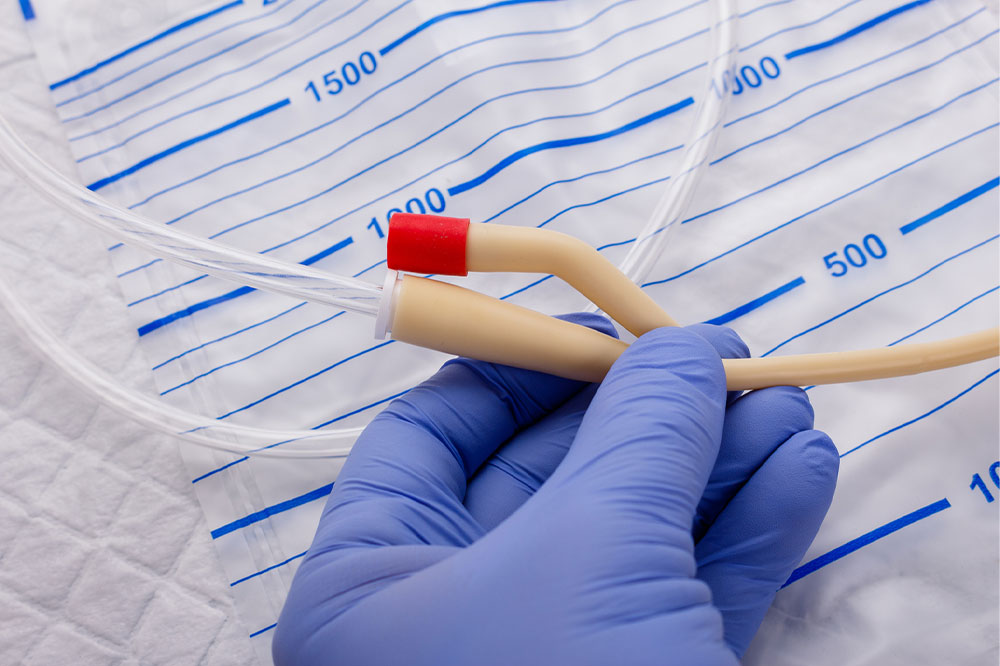
Types of urinary catheters and their side effects
A urinary catheter collects urine from the bladder through a thin tube connected to the device. It is recommended for those who have problems such as urine leakage, cannot empty the bladder, have undergone prostate or genital surgery, and for people who suffer from multiple sclerosis, dementia, and spinal cord injury. Urine catheters come in various shapes, sizes, and materials. Let’s understand the main types of urine catheters and their possible side effects.
Intermittent catheter (short-term catheter)
Intermittent catheters have a thin, flexible tube that is inserted through the urethra. The external tip is left open so that urine can be drained into a hole or emptied in an attached urine bag. After urinating once, the patient needs to remove the catheter and replace it with a new one. The urine can be drained through the urethra or by a surgical hole made in the lower abdomen. Patients must ask the healthcare providers to give them training and instruction on using this type of catheter correctly.
Intermittent catheters are typically used post-surgery to empty the bladder. Urinary tract infection (UTI) is one of the most common side-effects of using intermittent catheters. Another possible side effect is hematuria, which makes the urine appear brown or red because of the presence of red blood cells. It is likely that patients will catch hematuria when using this catheter for the first time, but if symptoms keep reappearing, it is a sign of a UTI. Intermittent catheters may cause bladder stones. Urinal strictures or narrowing of the urethra from repeated trauma may also occur. Those who use an intermittent catheter for a long period are more at risk of side effects.
Indwelling catheter
Indwelling catheters are typically used for a long time, unlike intermittent catheters. There is a small inflated balloon containing sterile water connected at the end of the catheter, so the thin tube does not slide from the body. When the catheter needs to be removed, the balloon is deflated. These types of catheters are inserted through the urethra. They are also known as urethral or Foley catheters. Indwelling catheters that are inserted through a surgically made hole in the lower abdomen are called suprapubic catheters. The urine is collected in a small drainage bag that is strapped to the patient’s inner thigh or positioned lower than the abdomen. It is important to drain the bag and replace it with a new, unused one once it’s full. There are also some types of indwelling catheters that have a valve to drain the urine. The valve needs to be opened when the patient needs to urinate. Some patients find indwelling catheters with valves more convenient than a drainage bag.
Let’s now understand its side effects. Blood spasms are a common one. These occur when the bladder tries to pass out from the balloon section. Doctors may prescribe antibiotics to decrease the frequency. Sometimes patients may notice debris in the tube of an indwelling catheter. This is a common occurrence that is considered normal, but it can block the tube and prevent drainage. Inform your doctor immediately if your catheter is blocked or if you notice blood clots or large pieces of debris. It is noticed that most indwelling catheters are not comfortable and often cause pain. It is suggested that you talk to your doctor for alternatives if the pain increases a lot.
External catheters (condom catheters)
As the name suggests, external catheters are placed outside the body. These are commonly used by individuals who have a penis and have mental conditions like dementia. External catheters are commonly referred to as condom catheters because their shape resembles a condom covering a penis head. This type is less painful and does not cause much discomfort as they are not inserted through the urethra. External catheters have a lower risk of urine infections, but it is important to change them daily. External catheters are available for individuals with vaginas. However, they are not recommended since they may damage the vaginal mucosa.
If you use external catheters for a long duration, you are at risk of catching a UTI. Common symptoms of UTI are fever, chills, headache, cloudy urine, burning sensation when urinating, blood or foul-smelling urine, and lower back pain. Sometimes people may get an allergic reaction from the material used to make catheters. If you spot any symptoms, it is suggested to consult your doctor immediately. Condom catheters may rarely cause damage to the penis.




